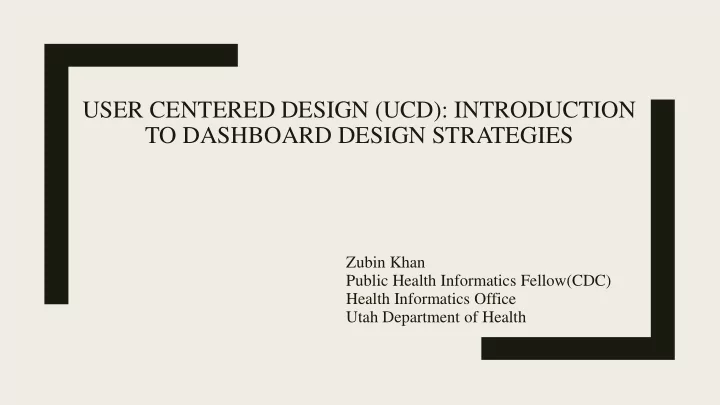

USER CENTERED DESIGN (UCD): INTRODUCTION TO DASHBOARD DESIGN STRATEGIES Zubin Khan Public Health Informatics Fellow(CDC) Health Informatics Office Utah Department of Health
Overview • Introduction • Background • UCD Principles • Phases of UCD • Methodology and Tools • Importance of UCD • Dashboard • Strategies for Dashboard Creation • Users Experience 2
What is User Centered Design? ■ User Centered Design (UCD) is an iterative design process in which designers and other stakeholders focus on the users and their needs in each phase of the design process. ■ UCD calls for involving users throughout the design process via a variety of research and design techniques so as to create highly usable and accessible products for them. — Definition of user-centered design (UCD) by the Interaction Design Foundation
User Centered Design What is UCD? Characteristics of UCD Understand user’s need Easy to use Meeting user’s need Easy to learn Fun Creating useful product
Five major UCD principles ■ A clear understanding of user and task requirements. ■ Incorporating user feedback to define requirements and design. ■ Early and active involvement of the user to evaluate the design of the product. ■ Integrating user centered design with other development activities. ■ Iterative design process.
Phases of the UCD process The following are the general phases of the UCD process: Specify the context of use: Identify the people who will use the product, what they will use it for, and under what conditions they will use it. Specify requirements: Identify any business requirements or user goals that must be met for the product to be successful. Create design solutions: This part of the process may be done in stages, building from a rough concept to a complete design. Evaluate designs: Evaluation - ideally through usability testing with actual users - is as integral as quality testing is to good software development.
Popular user centered design methods:
The following questions are typically asked during the UCD process: ■ Who uses your product? ■ What are their goals? ■ What are users searching for? ■ What are they interested in? ■ How do your users see the process of completing a task? ■ What do they say and how they do it? ■ How easy is it for your users to understand what they should do using your product? ■ How much time do users spend on figuring our how to actually do what they want to do? And many others.
Why is UCD Important?
Lets talk about UCD in Dashboard
The Design Process
UCD steps for creating a dashboard ■ Goals ■ Users ■ Data ■ Design and Layout ■ User Feedback ■ Designing Dashboard ■ Overall Best Practices
Goal - What data should we display? UX professionals can help their product teams avoid an initial scavenger hunt for data to display on a dashboard by getting their teams focused on user needs. What is a particular user’s main reason for visiting the dashboard? What triggers a user’s visiting the dashboard? How frequently would a user visit the dashboard? What is a user trying to assess? What critical decisions does a user have to make? Are there conditions of which we need to alert a user?
Users/Audience ■ You must know who will be the immediate audience that will use your dashboard. ■ No one dashboard fits all types of audience. ■ Find your users
Data- Where should we place the data? You need to decide how to arrange the data on a page — not based on the aesthetics of the page, but on the ways in which the information flow must support users’ workflows. What are the critical must-see or must-do items? What is the likely flow of a user’s focus? Is there a logical grouping scheme? Would a user want to compare some data with other data?
Layout - Use an intuitive layout There is a consensus among information visualization experts that a dashboard should be divided into 5 distinct regions, based on their eye-catching properties.
Data Representation Data representation is a complex task, especially if one wants to display multiple types of information in a dashboard, be it static or dynamic that changes over time.
When to use various graph types
Charts types to avoid
Users Feedback
Design the dashboard last
The 14 definitive dashboard design best practices:
We will test the user experience:
Bad Dashboard Design :
Good Dashboard Design:
JHU coronavirus dashboard (Thoughts)
References: ■ https://www.usability.gov/what-and-why/user-centered-design.html ■ https://uxplanet.org/10-rules-for-better-dashboard-design-ef68189d734c ■ https://www.uxmatters.com/mt/archives/2010/11/dashboard-design-101.php ■ https://www.uxmatters.com/mt/archives/2007/04/book-review-information- dashboard-design.php ■ https://www.datapine.com/blog/dashboard-design-principles-and-best-practices/ ■ Tableau conference ■ https://www.matillion.com/resources/blog/dashboard-examples-the-good- the-bad-and-the-ugly/
Thank you !!
Recommend
More recommend